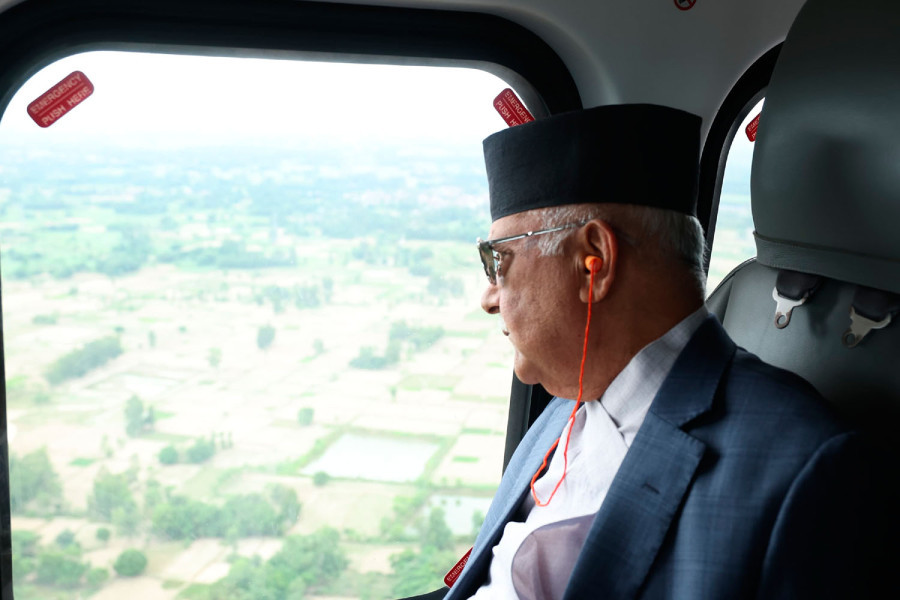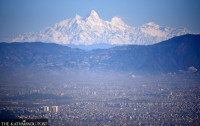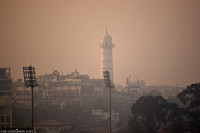Climate & Environment
PM’s aerial tour brings no relief to parched Madhesh
Climate change and lack of preparedness deepen crisis in the country’s breadbasket as ricefields lie unplanted.
Arjun Poudel
As drought grips the country’s southern plains, farmers hoping for rain may instead face a windstorm on Friday evening in parts of Madhesh and Koshi provinces, as meteorologists warn that chances of heavy or continuous rainfall remain slim.
The Meteorological Forecasting Division of the Department of Hydrology and Meteorology said that the chances of heavy or continuous rainfall, crucial for rice cultivation, are slim over the next three days in the areas affected by the ongoing drought-like conditions.
Despite both provincial and federal governments declaring Madhesh province a crisis zone, farmers in the region, who have been anxiously gazing at the sky hoping for rainfall, have yet to receive any assistance. They say they are unaware of what kind of relief they will receive or how long they will have to wait for it.
“We would be very relieved if any of the authorities set up a deep borewell immediately in our area,” said Lal Bahadur Shah, a farmer from ward 4 of Baragadhi Rural Municipality in Bara district. “In the absence of water, cultivated fields are cracking and rice saplings are withering. If the drought continues for a few more days, the newly planted saplings will burn to a crisp the sweltering sun.”
Shah and other farmers of the area met with the rural municipality chair on Friday and requested him to do everything possible to arrange water. However, after the meeting, they reached the conclusion that the ward chair could not do anything.
“I am worried about what to feed my 15-member family,” Shah complained. “Only about two-thirds of the land has been cultivated so far, and the cultivated lands are drying up and cracking due to drought.”
The chair of the rural municipality, Ashok Kumar Jaishwal, said dozens of farmers contact him every day to demand a deep borewell.
“We do not have a budget to set up borewells, and we have only heard the news about the declaration of a crisis zone in the Madhesh province,” said Jaishwal. “I don’t believe that the provincial or federal government would do anything substantive to provide relief to the affected people.”
Prime Minister KP Sharma Oli and his entourage of several leaders from ruling parties and Cabinet members air-toured the parched fields of the Madhesh province, but that, too, brought no relief to the affected farmers.
“Even if relief is declared for affected farmers, it will take months to arrive, and I don't believe anything would come,” said Jaishwal. “Farmers are asking for shallow tube wells and deep borewells, which could be set up within a week if the government showed urgency.”
Nepal is one of the world’s most vulnerable countries to the climate crisis. For over a decade, it has witnessed multiple extreme weather events. Experts say recurring extreme weather events, such as excessive rainfall in a short span, prolonged rains after the monsoon, frequent glacial lake outbursts, droughts, and above-average winter temperatures, show that the country is bearing the brunt of the climate crisis.
A drought in mid-monsoon in the Tarai region, which is also the country’s food basket, not only hits farmers but also the entire economy.
What alarms experts is that despite the emergency caused by the climate crisis, the country remains unprepared. According to them, neither the right infrastructure is being built to face the challenges nor are systems in place to address drought-like conditions.
“A prolonged ‘break’ in the monsoon caused drought-like conditions in Madhesh Province,” said Bibhuti Pokharel, information officer at the Department of Hydrology and Meteorology. “The effects of climate change and global warming have made these weather events more pronounced in recent years.”
Met officials say erratic weather events have already become the new normal in Nepal, and agencies concerned must prepare accordingly to cope with the new challenges.
Nepal has been experiencing changes in temperature and precipitation at a rate faster than the global average, according to studies. Evidence indicates that the maximum temperature in Nepal is rising at a greater rate (0.05 degrees Celsius per year) than the minimum temperature (0.03 degrees Celsius per year).
Scores of studies and scientific analyses over the decade and, more recently, the IPCC report, have warned that Nepal is one of the most vulnerable countries to the climate crisis and business-as-usual approach isn’t sufficient to tackle the adverse impacts of the crisis.




 6.1°C Kathmandu
6.1°C Kathmandu










